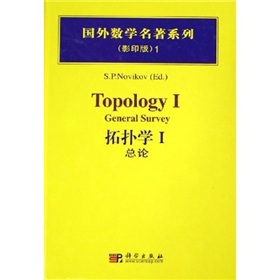国外数学名著系列:拓扑学1 电子书下载 PDF下载

内容简介
本书作者是拓扑学领域最知名的专家之一,曾获菲尔兹奖和沃尔夫数学奖。本书对整个拓扑学领域作出最新综述。依照诺维科夫自己的观点,拓扑学在19世纪末被称为位置分析,随后分为组合拓扑、代数拓扑、微分拓扑、同伦拓扑、几何拓扑等不同领域。本书从基本原理开始,随之阐述当前的研究前沿,概述这些领域;第二章介绍纤维空间;第三章论述CW-复形、同调和同伦理论、配边理论、K-理论及亚当斯-诺维科夫谱序列;第四章全面讲座流形理论。附录阐述纽结和连接理论及低维拓扑中的最新进展。
·查看全部>>
目录
Introduction
Introduction to the English Translation
Chapter 1. The Simplest Topological Properties
Chapter 2. topological Spaces. Fibrations. Homotopies
1. Observations from general topology. Terminology
2. Homotopies. Homotopy type
3. Covering homotopies. Fibrations
4. Homotopy groups and fibrations. Exact sequences. Examples
Chapter 3. Simplicial Complexes and CW-complexes. Homology and Cohomology. Their Relation to Homotopy Theory. Obstructions
1. Simplicial complexes
2. The homology and cohomology groups.Poincare duality
3. Relative homology. The exact sequence of a pair. Axioms for homology theory. CW-complexes
4. Simplicial complexes and other homology theories. Singular homulogy. Coverings and sheaves. The exact sequence of sheaves and cohomology
5. Homology theory of non-simply-connected spaces. Complexes of modules. Reidemeister torsion. Simples homotopy type
6. Simplicial and cell bundles with a structure group. Obstructions. Universal lbjects: universal fiber bundles and the universal property of Eilenberg-MacLane complexes. Cohomology operations. The Steenrod algebra. The Adams spectral sequence
7. The classical apparatus of homotopy theory. The Laray spectral sequence. The homology theory of fiber bundles. The Cartan-Serre method. The Postnikov tower. The Adams spectral sequence
8. Definition and properties of K-theory. The Atiyah-Hirzebruch spectral sequence. Adams operations. Analogues of the Thom isomorphism and the Riemann-Roch theorem. Elliptic operators and K-theory. Transformation groups. Four-dimensional manifolds
9. Bordism and cobordism theory as generalized homology and cohomology. Cohomology operations in cobordism. The Adams-Novikov spectral sequence. Formal groups. Actions of cyclic groups and the circle on manifolds
Chapter 4. Smooth Manifolds
1. Basic concepts. Smooth fiber bundles. Connexions. Characteristic classes
2. The homology theory of smooth manifolds. Complex manifolds. The classical global calculus of variations. H-spaces. Multi-valued functions and functionals
3. Smooth manifolds and homotopy theory. Framed manifolds. Bordisms. Thom spaces. The Hirzebruch formulae. Estimates of the orders of homotopy groups of spheres. Milnors example. The integral properties of cobordisms
4. Classification problems in the theory of smooth manifolds. The theory of immersions. Manifolds with the homotopy type of a sphere. Relationships between smooth and PL-manifolds. Integral Pontryagin classes
5. The role of the fundamental group in topology. Manifolds of low dimension (n=2,3). Knots. The boundary of an open manifold. The classification invariance of the rational Pontryagin classes. The classification theory of non-simply-connected manifolds of dimension>5. Higher signatures. Hermitian K-theory. Geometric topology: the construction of non-smooth homeomorphisms. Milnors example. The annulus conjecture. Topological and PL-structures
Concluding Remarks
Appendix. Recent Developments in the Topology of 3-manifolds and Knots
1. Introduction: Recent developments in Topology
2. Knots: the classical and modern approaches to the Alexander polynomial. Jones-type polynomials
3. Vassiliev Invariants
4. New topological invariants for 3-manifolds. Topological Quantum Field Theories
Bibliography
Index
Introduction to the English Translation
Chapter 1. The Simplest Topological Properties
Chapter 2. topological Spaces. Fibrations. Homotopies
1. Observations from general topology. Terminology
2. Homotopies. Homotopy type
3. Covering homotopies. Fibrations
4. Homotopy groups and fibrations. Exact sequences. Examples
Chapter 3. Simplicial Complexes and CW-complexes. Homology and Cohomology. Their Relation to Homotopy Theory. Obstructions
1. Simplicial complexes
2. The homology and cohomology groups.Poincare duality
3. Relative homology. The exact sequence of a pair. Axioms for homology theory. CW-complexes
4. Simplicial complexes and other homology theories. Singular homulogy. Coverings and sheaves. The exact sequence of sheaves and cohomology
5. Homology theory of non-simply-connected spaces. Complexes of modules. Reidemeister torsion. Simples homotopy type
6. Simplicial and cell bundles with a structure group. Obstructions. Universal lbjects: universal fiber bundles and the universal property of Eilenberg-MacLane complexes. Cohomology operations. The Steenrod algebra. The Adams spectral sequence
7. The classical apparatus of homotopy theory. The Laray spectral sequence. The homology theory of fiber bundles. The Cartan-Serre method. The Postnikov tower. The Adams spectral sequence
8. Definition and properties of K-theory. The Atiyah-Hirzebruch spectral sequence. Adams operations. Analogues of the Thom isomorphism and the Riemann-Roch theorem. Elliptic operators and K-theory. Transformation groups. Four-dimensional manifolds
9. Bordism and cobordism theory as generalized homology and cohomology. Cohomology operations in cobordism. The Adams-Novikov spectral sequence. Formal groups. Actions of cyclic groups and the circle on manifolds
Chapter 4. Smooth Manifolds
1. Basic concepts. Smooth fiber bundles. Connexions. Characteristic classes
2. The homology theory of smooth manifolds. Complex manifolds. The classical global calculus of variations. H-spaces. Multi-valued functions and functionals
3. Smooth manifolds and homotopy theory. Framed manifolds. Bordisms. Thom spaces. The Hirzebruch formulae. Estimates of the orders of homotopy groups of spheres. Milnors example. The integral properties of cobordisms
4. Classification problems in the theory of smooth manifolds. The theory of immersions. Manifolds with the homotopy type of a sphere. Relationships between smooth and PL-manifolds. Integral Pontryagin classes
5. The role of the fundamental group in topology. Manifolds of low dimension (n=2,3). Knots. The boundary of an open manifold. The classification invariance of the rational Pontryagin classes. The classification theory of non-simply-connected manifolds of dimension>5. Higher signatures. Hermitian K-theory. Geometric topology: the construction of non-smooth homeomorphisms. Milnors example. The annulus conjecture. Topological and PL-structures
Concluding Remarks
Appendix. Recent Developments in the Topology of 3-manifolds and Knots
1. Introduction: Recent developments in Topology
2. Knots: the classical and modern approaches to the Alexander polynomial. Jones-type polynomials
3. Vassiliev Invariants
4. New topological invariants for 3-manifolds. Topological Quantum Field Theories
Bibliography
Index
同类热门电子书下载更多
Copyright © 2025 by topbester.com.
All Rights Reserved.
沪ICP备14027842号-1
All Rights Reserved.
沪ICP备14027842号-1